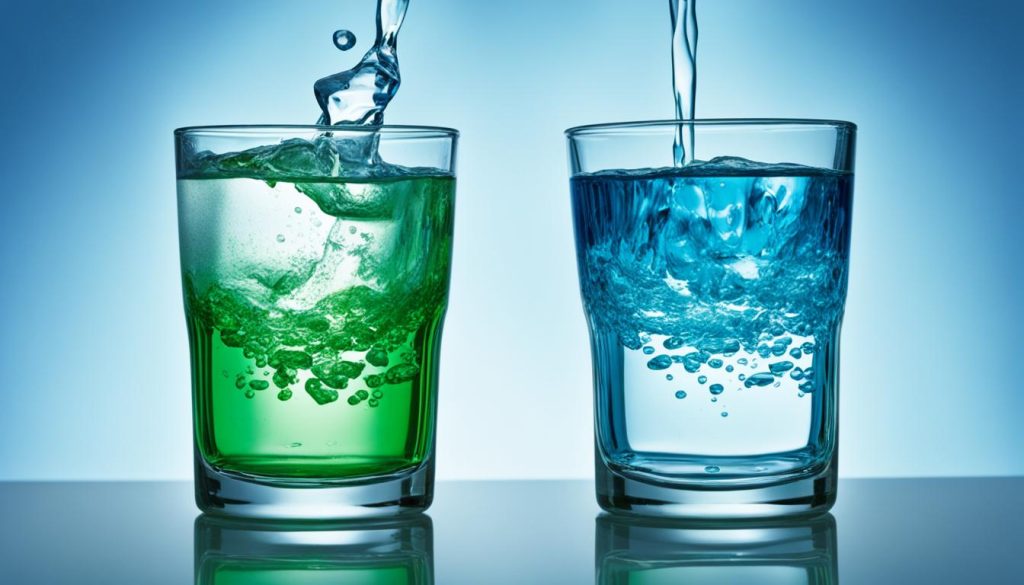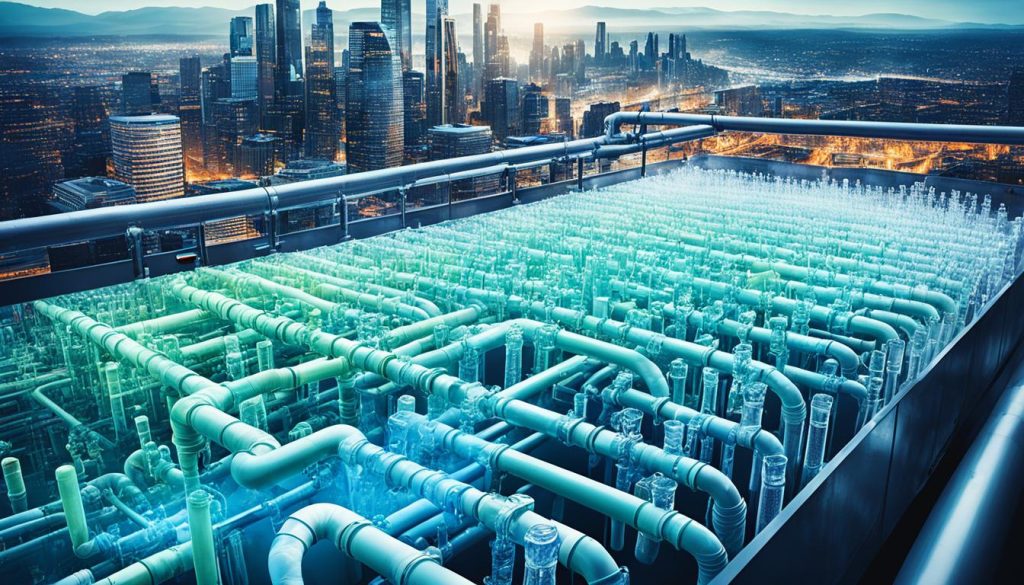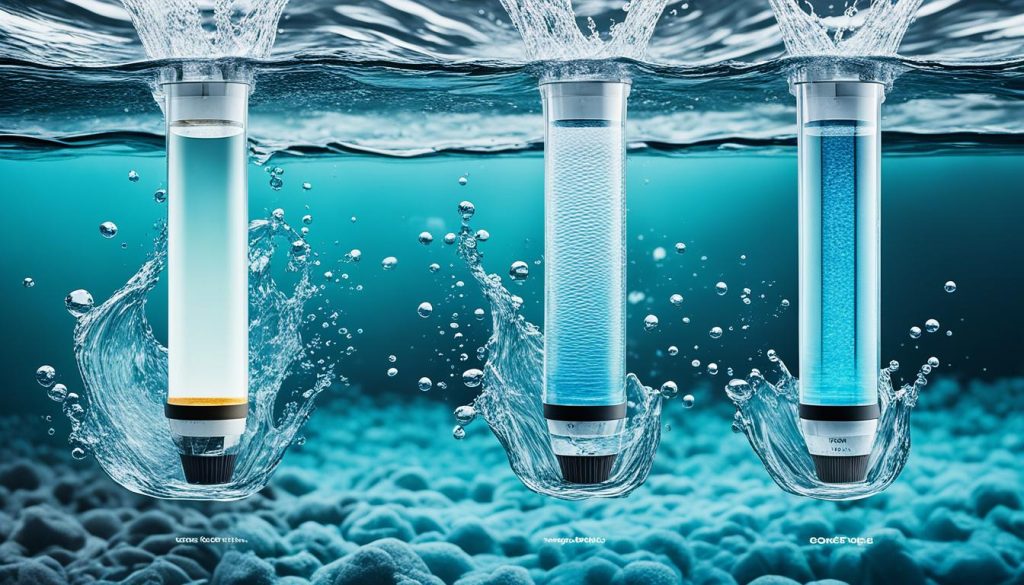Did you know that urban water treatment plants in the United States supply approximately over 42 billion gallons of water per day? With the ever-growing population and increasing demand, ensuring sustainable and efficient urban water procurement and purification has become imperative. In this article, we will explore the latest insights and trends in urban water procurement and purification, highlighting the challenges, innovations, and best practices in this field.
Key Takeaways:
- Urban water treatment plants in the US supply over 42 billion gallons of water daily.
- Ensuring sustainable and efficient urban water procurement and purification is crucial.
- This article explores the latest insights and trends in urban water procurement and purification.
- Challenges, innovations, and best practices in this field are discussed.
- Stay informed about the crucial role of urban water management for a sustainable future.
The Difference Between Chlorine and Chloramines in Water Treatment.
Chlorine and chloramines are two commonly used disinfectants in the process of water treatment. While both serve the purpose of killing harmful bacteria and viruses, they differ in terms of their impact on water quality and safety.

Chlorine has long been the primary disinfectant used in water treatment. It effectively neutralizes bacteria and viruses, making water safe for consumption. However, chlorine also has some drawbacks that need to be considered. One of the main concerns is the creation of harmful byproducts during the disinfection process. These byproducts, known as disinfection byproducts (DBPs), can pose health risks if present in high levels. Additionally, the use of chlorine can affect the taste and odor of water, leaving a noticeable chemical or “pool-like” smell in some cases. Another limitation of chlorine is its limited staying power in the water distribution system. As water travels from treatment plants to households, the chlorine concentration gradually decreases, potentially leading to reduced disinfection efficacy.
On the other hand, chloramines offer a more favorable alternative disinfectant. Chloramines are formed by combining chlorine with ammonia. They provide a more stable and longer-lasting disinfection effect compared to chlorine alone. One advantage of chloramines is that they produce lower levels of disinfection byproducts, addressing the health concerns associated with chlorine. Moreover, chloramines have a lesser impact on water taste and odor, resulting in a more pleasant drinking experience. Due to their staying power, chloramines remain in tap water for a longer period, providing ongoing protection against other toxins that may enter the distribution system.
Despite their advantages, it’s important to note that chloramines can cause skin, hair, and eye irritation in some individuals. Certain groups, such as kidney dialysis patients and owners of aquariums with fish sensitive to ammonia, need to be cautious and take appropriate measures to remove chloramines from their water supply.
Key Points:
- Chlorine and chloramines are commonly used as disinfectants in water treatment.
- Chlorine disinfection can create harmful byproducts and impact water taste and odor.
- Chloramines are a combination of chlorine and ammonia and offer a more stable disinfection option.
- Chloramines produce lower levels of byproducts and have a lesser impact on water taste and odor.
- Chloramines remain in tap water for a longer period, providing ongoing protection against other toxins.
- Chloramines can cause skin, hair, and eye irritation and pose risks to certain individuals.
| Chlorine | Chloramines |
|---|---|
| Primary disinfectant for water treatment | Alternative disinfectant to chlorine |
| Creation of disinfection byproducts | Lower levels of disinfection byproducts |
| Impact on water taste and odor | Less impact on water taste and odor |
| Limited staying power in the water distribution system | Longer-lasting disinfection effect |
| Protection against other toxins in tap water | |
| Potential skin, hair, and eye irritation |
Concerns about Bacteria, Cysts, and Viruses in Urban Water.
Ensuring the quality of urban water is of utmost importance, with concerns surrounding bacteria, cysts, and viruses being significant. While the percentage of people prioritizing these contaminants has decreased compared to the previous year, the COVID-19 pandemic has raised awareness about the presence of waterborne pathogens. This has led many Americans to become more concerned about bacteria, cysts, and viruses in their water due to the pandemic.
The COVID-19 pandemic has highlighted the importance of effective water filtration and treatment to ensure safe and clean drinking water. Waterborne contaminants, including bacteria, cysts, and viruses, pose risks to public health, and robust filtration systems play a vital role in removing these pathogens.
Waterborne Contaminants
Bacteria, such as E. coli and Legionella, can cause illnesses like gastrointestinal infections and Legionnaires’ disease. Cysts, like those produced by the parasite Cryptosporidium, are resistant to chlorine disinfection and can cause severe gastrointestinal illness. Viruses, such as norovirus and hepatitis A, also pose health risks if present in drinking water.
The COVID-19 pandemic has created a heightened awareness of the potential for viruses, including the SARS-CoV-2 virus responsible for COVID-19, to be present in water sources. While the primary mode of transmission for COVID-19 is through respiratory droplets, the virus has been detected in fecal matter and could potentially contaminate water supplies.
The Importance of Water Filtration
Proper water filtration systems are essential for removing bacteria, cysts, and viruses from urban water sources. Filtration technologies, such as activated carbon filters and microfiltration membranes, effectively capture and remove these contaminants, ensuring safe drinking water for the population.
Water filtration provides an additional layer of protection against waterborne diseases and can significantly improve the overall quality of urban water. By removing harmful bacteria, cysts, and viruses, filtration systems mitigate health risks and instill confidence in the safety of drinking water.
Common Waterborne Contaminants and their Health Risks
| Contaminant | Health Risks |
|---|---|
| Bacteria | Gastrointestinal infections, Legionnaires’ disease |
| Cysts | Severe gastrointestinal illness |
| Viruses | Gastrointestinal infections, hepatitis A, norovirus |
| SARS-CoV-2 | Potential risk of COVID-19 transmission |
Protecting urban water sources from bacteria, cysts, and viruses through effective filtration is critical for safeguarding public health. The COVID-19 pandemic has highlighted the importance of water filtration in ensuring the safety and cleanliness of drinking water. By implementing robust filtration systems, urban areas can provide their residents with reliable access to high-quality water.

Health as a Driving Factor for Water Filtration.
Health is a top priority for Americans, especially in the post-COVID-19 world. The pandemic has heightened concerns about overall health and the quality of drinking water. A significant percentage of Americans are now more concerned about the quality of unfiltered water in their homes due to COVID-19. Proper hydration with clean and filtered water is essential for maintaining good health and reducing the risk of waterborne diseases. This increased focus on health has led to a rise in the popularity of water filtration systems to ensure the safety and purity of drinking water.
Filtered water provides numerous health benefits. It removes impurities and contaminants that can negatively impact our well-being. By eliminating harmful substances like chlorine, lead, and bacteria, water filtration systems enhance the taste, odor, and appearance of drinking water. This improvement encourages individuals to drink more water and stay properly hydrated, supporting overall health and well-being.
Waterborne diseases continue to be a significant concern, particularly in areas with inadequate water treatment facilities. Filtration systems play a crucial role in preventing the transmission of waterborne diseases by removing pathogens such as bacteria, viruses, and parasites. These systems act as an additional line of defense, ensuring that the water we consume is free from potentially harmful microorganisms.
“Water filtration systems not only provide peace of mind but also contribute to our overall health by delivering clean, pure water that meets our quality standards.”
In addition to protecting our health, water filtration systems also help mitigate the environmental impact of single-use plastic bottles. By opting for filtered water at home, individuals reduce their reliance on bottled water and contribute to the reduction of plastic waste.

The image above depicts a water filtration system, highlighting the importance of filtering water for health and safety.
Environmental Considerations for Water Filtration.
The environment plays a vital role in driving the adoption of water filtration systems. With growing concerns about the impact of global warming and the need for sustainable practices, many consumers are prioritizing the purchase of eco-friendly and sustainable products, including water filtration systems.
One significant environmental benefit of water filtration systems is the reduction of plastic waste. By switching from single-use plastic bottles to water filters, individuals can minimize their contribution to the plastic pollution problem. Not only does this help protect the environment, but it also leads to cost savings in the long run, as filters are reusable and more cost-effective than purchasing bottled water.
Water filtration systems are inherently eco-friendly. They provide a sustainable solution for clean drinking water by removing contaminants and impurities, making tap water safer and more enjoyable. By investing in water filtration systems, individuals can actively contribute to reducing their ecological footprint while ensuring access to high-quality drinking water.
The “Eco-wakening” Phenomenon
The rise in environmentally-conscious consumers seeking sustainable options has given rise to the “Eco-wakening” phenomenon. This refers to a growing trend of individuals actively seeking out eco-friendly and sustainable products in various aspects of their lives, including water filtration.
The shift towards environmentally-friendly water filtration systems aligns with the broader movement towards sustainability and responsible consumption. As more people recognize the importance of protecting the environment, the demand for eco-friendly alternatives to single-use plastic bottles continues to grow.
Lack of Trust in Water Quality and the Need for Water Filtration.
Many Americans lack trust in the quality of their tap water, leading to the need for water filtration. Despite extensive treatment processes, there is still a risk of recontamination as water travels from treatment facilities to homes. Factors like knowledge about water quality and concern about contaminants have increased significantly. This growing awareness and concern have led to a higher percentage of people advocating for the necessity of filtering tap water.
Water filtration systems provide a trusted solution for ensuring clean and safe drinking water. By removing impurities and contaminants, these systems enhance water quality and alleviate consumer concerns. The use of advanced filtration technologies helps address contamination risks, giving consumers peace of mind about the water they consume.
| Benefits of Water Filtration Systems | Consumer Concerns Addressed |
|---|---|
| Improves water taste and odor | Elimination of unpleasant odors and tastes |
| Removes harmful chemicals and toxins | Reduces the risk of exposure to contaminants |
| Filters out bacteria, viruses, and cysts | Enhances water safety and hygiene |
| Provides access to clean drinking water at all times | Eliminates uncertainties about tap water quality |
Filtration systems offer a reliable and convenient solution for households concerned about their water quality. By installing a water filtration system, consumers can take control of their water supply, ensuring that it meets their standards for safety and taste.
Consumer Quotes:
“Having a water filtration system has given me peace of mind knowing that my family is drinking clean and safe water.”
“I used to worry about the quality of tap water, but since installing a filtration system, I feel confident and trust the water that comes out of my faucet.”
- Increased trust in water quality
- Protection against contamination risks
- Improved taste and odor of water
- Assurance of safe drinking water
- Convenience and peace of mind
With consumer concerns about tap water quality on the rise, the demand for water filtration systems continues to grow. By addressing issues of trust and contamination risks, these systems play a vital role in ensuring access to clean and safe drinking water for households across America.
Market Growth and Key Players in the Water Filtration Unit Industry.
The water filtration unit market has witnessed substantial growth in recent years, thanks to the rising demand from consumers and the advent of new market players. Technological advancements have also played a crucial role in driving the market forward, enabling the development of innovative filtration technologies.
The market offers a range of filtration technologies, including Reverse Osmosis (RO)-based and Ultraviolet (UV)-based systems. These technologies have gained popularity due to their effectiveness in removing impurities and ensuring clean drinking water.
When it comes to key players in the water filtration unit industry, several names stand out. These companies have made significant contributions to the market and continue to drive innovation:
- 3M
- A.O.Smith
- Amway eSpring
- BRITA
- Culligan Water
These companies have been at the forefront of developing cutting-edge filtration technologies and offering a wide range of products to cater to different customer needs. Whether it’s residential or commercial applications, these key players provide diverse options for consumers seeking water filtration solutions.
With the continued growth of the water filtration unit market, it is expected that more players will enter the industry, further driving innovation and providing consumers with an even wider range of choices.
Adaptation Strategies for Urban Water Resources.
Adaptation strategies play a crucial role in ensuring the resilience of urban water resources in the face of climate change and other challenges. As cities grapple with the increasing risks posed by changing weather patterns and water scarcity, effective adaptation becomes essential to ensure water security and sustainable urban development.
Developing adaptation strategies requires a comprehensive understanding of the local conditions and future climate risks. Each city has its own unique set of circumstances, including geographical location, population density, and existing water infrastructure. By assessing these factors, urban planners and policymakers can tailor adaptation measures to meet specific needs.
Long-term planning is a key aspect of successful adaptation strategies. Cities must consider the projected changes in climate and water availability over several decades. This long-term perspective allows for the implementation of measures that can withstand the uncertainties associated with climate change.
When it comes to investment in adaptation, it is crucial to focus on low-regret options that promote both water security and economic development. These options minimize potential risks and uncertainties while maximizing the benefits for urban communities. Financial investment in infrastructure upgrades, technological advancements, and sustainable water management practices can contribute to the long-term viability of urban water resources.
Furthermore, effective governance, coordination, and collaboration among stakeholders are vital in implementing adaptation strategies. Public and private entities, community organizations, and government agencies must work together to overcome barriers and ensure the successful implementation of adaptation measures. This requires transparent decision-making processes, proactive engagement with affected sectors, and the allocation of resources to support adaptation efforts.
By embracing adaptation strategies, urban areas can enhance their resilience against climate risks and safeguard their water resources for future generations. Through long-term planning, financial investment, and effective governance, cities can navigate the challenges posed by climate change and ensure the sustainable management of their urban water systems.
Image Caption: Adaptation strategies for urban water resources ensure water security in the face of climate change.
Achieving Water Security in Urban Areas.
Achieving water security in urban areas is a critical challenge, particularly in light of climate change impacts. Urban water systems face increasing pressure due to extreme weather events, rising sea levels, and changes in surface and groundwater. Ensuring water availability and managing costs are significant considerations for urban water planners. Decisions made now will have long-term implications for water supply, industry, and agriculture. Sustainable water management practices are crucial for maintaining water security in urban areas.
Factors Impacting Water Security
There are several factors that contribute to the challenge of achieving water security in urban areas:
- Climate Change Impacts: The effects of climate change, such as increased droughts and floods, disrupt the availability and reliability of water resources in urban areas.
- Urban Water Systems: Aging infrastructure and inadequate water management practices contribute to the vulnerability of urban water systems.
- Water Availability: Growing population and increased water demand put strain on existing water sources, leading to potential shortages.
- Water Costs: Balancing the cost of water supply and treatment with affordability for residents and businesses is a complex challenge.
Sustainable Water Management
To address these challenges and achieve water security, sustainable water management practices are essential:
- Water Conservation: Implementing water conservation measures, such as efficient irrigation systems, water reuse, and public awareness campaigns, can help reduce water demand and ensure long-term water availability.
- Infrastructure Investment: Upgrading and maintaining infrastructure, including water treatment plants, distribution networks, and storage facilities, is crucial for enhancing the resilience of urban water systems.
- Better Governance: Effective governance and regulation, along with stakeholder collaboration, play a vital role in managing water resources and ensuring equitable access to clean water.
- Integrated Planning: Integrated water resource management, considering the entire water cycle and incorporating climate change projections, helps identify risks and develop adaptive strategies.
Case Study: Sustainable Water Management in City X
“City X has taken significant steps towards achieving water security through sustainable water management practices. The city has implemented a comprehensive water conservation program, promoting efficient water use and providing incentives for residents and businesses to adopt water-saving technologies. Additionally, City X has invested in upgrading its water infrastructure, improving treatment plants, and implementing smart water technologies for monitoring and managing water resources. These initiatives have not only increased water availability but also reduced costs and improved the resilience of the urban water system. City X serves as a model for other cities striving to achieve water security in the face of climate change impacts.”
Comparison of Water Management Strategies
| Water Management Strategies | Pros | Cons |
|---|---|---|
| Water Conservation | – Reduces water demand and promotes sustainability – Cost-effective in the long run | – Requires behavior change and public awareness – Initial investment may be required |
| Infrastructure Investment | – Enhances water system resilience – Improves water quality and reliability | – High upfront costs – Disruption during construction |
| Better Governance | – Ensures effective water resource management – Promotes equitable access to clean water | – Requires coordination among multiple stakeholders – Political challenges |
| Integrated Planning | – Identifies risks and develops adaptive strategies – Considers long-term climate change impacts | – Requires data collection and analysis – Complex decision-making process |
By implementing sustainable water management practices and considering the unique challenges of urban areas, cities can work towards achieving water security for their residents and future generations. It requires a holistic approach that combines conservation, infrastructure investment, governance, and integrated planning to ensure the availability, affordability, and resilience of urban water systems.
Conclusion
In conclusion, urban water procurement and purification are crucial components of sustainable and efficient urban water treatment solutions. The insights and trends discussed in this article have shed light on the challenges and innovations in the field of water purification. Factors such as health concerns, environmental considerations, and a lack of trust in water quality have led to the increased adoption of water filtration systems.
To ensure water security and address the impacts of climate change, it is essential to implement adaptation strategies and sustainable water management practices. This includes long-term planning, financial investment, and effective governance to meet the water needs of urban areas. By prioritizing clean and safe drinking water, we can safeguard the well-being of urban populations.
The growing water filtration unit market offers a wide range of filtration technologies provided by key players in the industry. These solutions cater to the diverse needs of consumers seeking reliable water filtration systems. From RO-based systems to UV-based systems, there are various options available to ensure access to clean and purified water.
In conclusion, by combining urban water procurement, water purification insights, sustainable water management, and water filtration solutions, we can create a future where clean and safe water is readily available to all, ensuring the health and well-being of urban communities.
